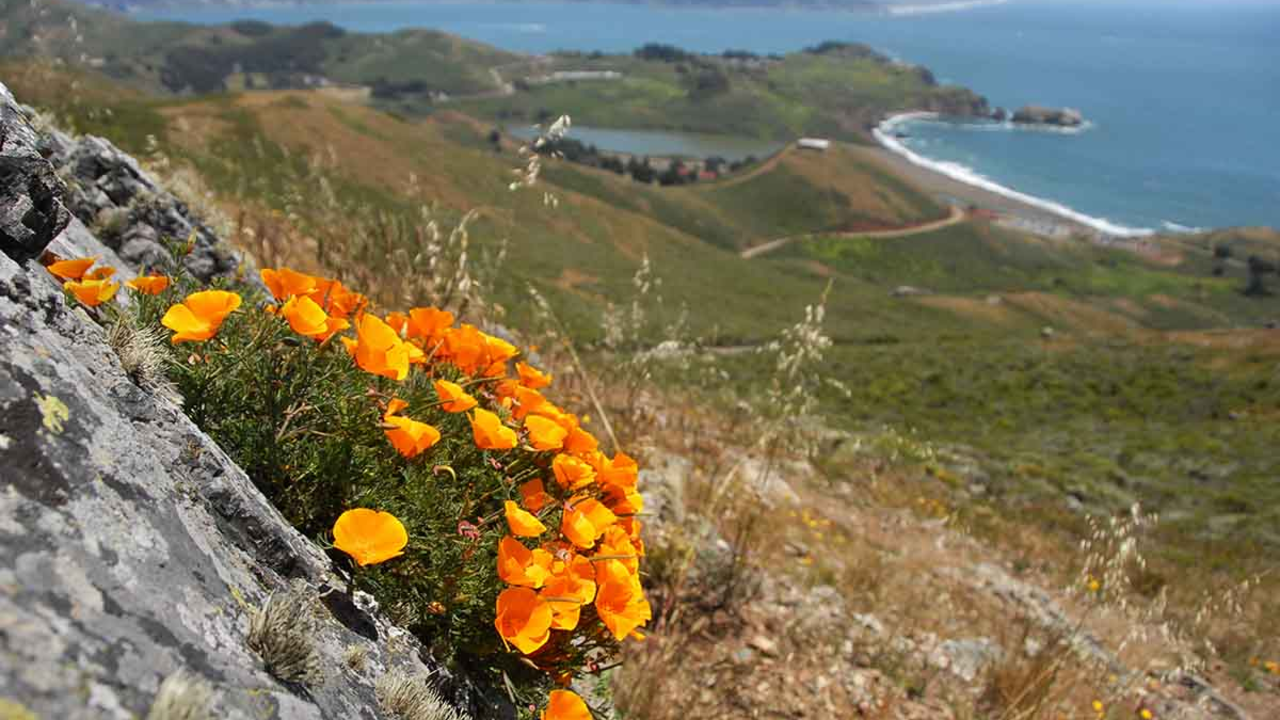Beyond the super bloom: Why wildflowers are so important to Bay Area parks

Jessica Weinberg McClosky / Parks Conservancy
By Kimberly Guo
Park Stewardship Marin Intern
If April showers bring May flowers, then what do January, February, and March showers bring? In California, they bring a super bloom of flowers vivid enough to be seen from space! Super blooms are flowering events that exceed typical spring blooms, and they typically occur after heavier-than-average precipitation, which would be an apt description for this past winter.
Although the wildflowers are numerous and diverse in a super bloom, there are still reasons to not step on or pick your local wildflowers. (As a reminder, it is illegal to pick or collect plants in national forests, parks, and monuments without a permit!)
1. Wildflowers support ecosystems and pollinators (and us!)
Wildflowers are the backbone of ecosystems for pollinators, beneficial insects, birds, and other small animals. Wildflowers provide seeds, nectar, pollen, and leaves as a source of food and life, especially for pollinators that have small home ranges or that depend on one or two specific host plant species, such as the Mission blue butterfly. They also support people, directly and indirectly. We use wildflowers in herbal medicinal remedies, and we depend on the pollinators that depend on the wildflowers!
2. Native wildflowers have co-evolved with their area’s climate and pollinators
Studies have shown that native wildflowers are four times more attractive to pollinators than non-native wildflowers! Some native wildflowers cater specifically to their pollinators, and have evolved a particular shape, color, size, and flowering season to attract their target pollinator. Additionally, because native wildflowers have co-evolved with an area’s climate and pollinators, they usually require less water and fertilizer to grow, are less prone to disease, and are more tolerant to pests. Wildflowers can improve soil health, prevent erosion, improve water quality, and increase crop yields.
3. Wildflowers are fragile
Unfortunately, wildflowers become far less beautiful once picked—they wilt shortly after being separated from the other parts of the plant, which had been providing the flower with water and sugar. Stepping on wildflowers (even for a quick photo!) harms them in a similar way and even prevents wildflowers in the future from growing on these foottrails. Just one flower getting picked would not do much damage to the ecosystem, but if everyone visiting a natural area with wildflowers picked one flower (consider that the Golden Gate National Recreation Area has more than 17 million annual visitors), then the impact on the landscape would be insurmountable. Picking a flower causes that plant to lose its reproductive ability, so in the future, there could be less wildflower seeds in the ground. Picking flowers also means other people won’t be able to enjoy them, nor will the pollinators and other animals that depend on wildflowers for food and cover.
Now that you know why wildflowers are important and how you can enjoy them without harming them, it’s time to go wildflower hunting! (Figuratively speaking, of course.)
The National Park Service has published a brochure of the wildflowers commonly found throughout the Golden Gate National Parks. We at Marin Park Stewardship have also put together a picture guide of the common wildflowers in our Marin parklands, which we designed so that it could be folded up and put into a pocket. Find that here!
Let us know what wildflowers you spot out in our parks!
Information sources:
https://www.americanmeadows.com/wildflower-gardening/wildflower-facts/w…
https://www.fs.fed.us/wildflowers/aboutus.shtml
https://www.fs.fed.us/wildflowers/ethics/index.shtml
https://www.nrcs.usda.gov/wps/portal/nrcs/detail/national/newsroom/feat…
https://www.bbc.com/news/av/world-us-canada-39671753/wildflower-super-b…
https://news.nationalgeographic.com/2017/03/california-desert-anza-borr…
https://www.housebeautiful.com/lifestyle/a26860532/wildflower-super-blo…
https://earthobservatory.nasa.gov/images/144686/wildflower-super-bloom-…